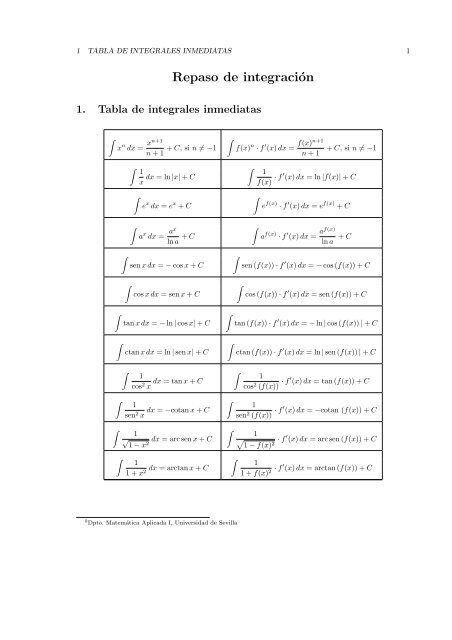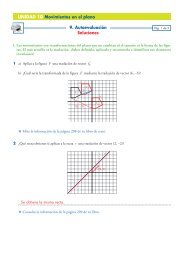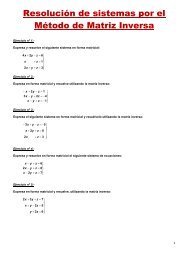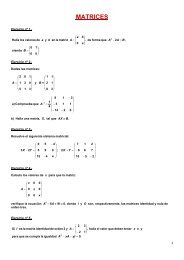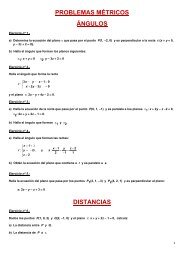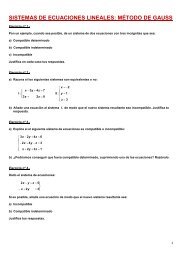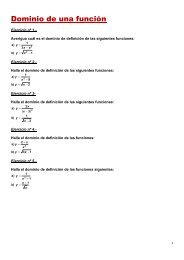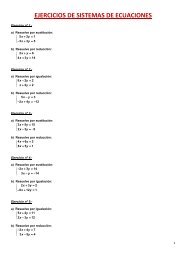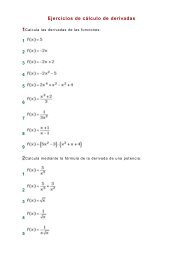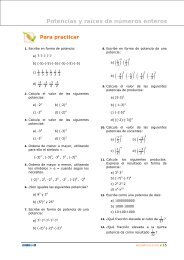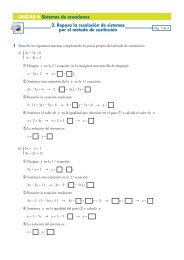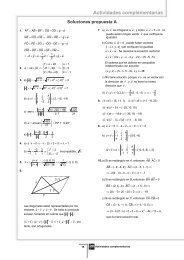Tabla de integrales - Amolasmates
Tabla de integrales - Amolasmates
Tabla de integrales - Amolasmates
You also want an ePaper? Increase the reach of your titles
YUMPU automatically turns print PDFs into web optimized ePapers that Google loves.
1 TABLA DE INTEGRALES INMEDIATAS 1<br />
Repaso <strong>de</strong> integración<br />
1. <strong>Tabla</strong> <strong>de</strong> <strong>integrales</strong> inmediatas<br />
<br />
<br />
<br />
x n dx = xn+1<br />
+ C, si n = −1<br />
n + 1<br />
<br />
<br />
<br />
<br />
<br />
<br />
1<br />
dx = ln |x| + C<br />
x<br />
<br />
<br />
e x dx = e x + C<br />
a x dx = ax<br />
+ C<br />
ln a<br />
sen x dx = − cos x + C<br />
cos x dx = sen x + C<br />
tan x dx = − ln | cos x| + C<br />
<br />
ctan x dx = ln | sen x| + C<br />
1<br />
cos2 dx = tan x + C<br />
x<br />
1<br />
sen2 dx = −cotan x + C<br />
x<br />
1<br />
√ dx = arc sen x + C<br />
1 − x2 1<br />
dx = arctan x + C<br />
1 + x2 0 Dpto. Matemática Aplicada I, Universidad <strong>de</strong> Sevilla<br />
<br />
<br />
<br />
<br />
<br />
<br />
<br />
f(x) n · f ′ (x) dx = f(x)n+1<br />
n + 1<br />
<br />
<br />
<br />
<br />
+ C, si n = −1<br />
1<br />
f(x) · f ′ (x) dx = ln |f(x)| + C<br />
e f(x) · f ′ (x) dx = e f(x) + C<br />
a f(x) · f ′ (x) dx = af(x)<br />
ln a<br />
+ C<br />
sen (f(x)) · f ′ (x) dx = − cos (f(x)) + C<br />
cos (f(x)) · f ′ (x) dx = sen (f(x)) + C<br />
tan (f(x)) · f ′ (x) dx = − ln | cos (f(x)) | + C<br />
<br />
ctan (f(x)) · f ′ (x) dx = ln | sen (f(x)) | + C<br />
1<br />
cos 2 (f(x)) · f ′ (x) dx = tan (f(x)) + C<br />
1<br />
sen 2 (f(x)) · f ′ (x) dx = −cotan (f(x)) + C<br />
1<br />
1 − f(x) 2 · f ′ (x) dx = arc sen (f(x)) + C<br />
1<br />
1 + f(x) 2 · f ′ (x) dx = arctan (f(x)) + C
2 FÓRMULA DE INTEGRACIÓN POR PARTES 2<br />
2. Fórmula <strong>de</strong> integración por partes<br />
<br />
<br />
udv = uv −<br />
La fórmula <strong>de</strong> integración por partes es aplicable cuando el integrando se pue<strong>de</strong> expresar como producto<br />
<strong>de</strong> dos funciones, una <strong>de</strong> las cuales, dv, tiene integral inmediata y la otra, u, al <strong>de</strong>rivarla, nos<br />
conduce a una función, du, <strong>de</strong> modo que el nuevo integrando vdu sea más sencillo.<br />
<br />
Ejemplo 1. Hallar la integral x cos x dx.<br />
Resolución.<br />
<br />
<br />
u = x<br />
x cos x dx =<br />
dv = cos x dx<br />
du = dx<br />
v = − sen x<br />
<br />
Ejemplo 2. Hallar la integral<br />
Resolución.<br />
<br />
x 2 e x dx =<br />
=<br />
x 2 e x dx.<br />
u = x 2 du = 2x dx<br />
dv = e x dx v = e x<br />
u = 2x du = 2 dx<br />
dv = e x dx v = e x<br />
<br />
Ejemplo 3. Hallar la integral e x cos x dx.<br />
<br />
Resolución. Denotemos por I = e x cos x dx.<br />
<br />
I = e x cos x dx =<br />
=<br />
Despejando I, tenemos que<br />
<br />
<br />
<br />
vdu<br />
<br />
= −x sen x −<br />
= x 2 e x <br />
−<br />
2xe x dx<br />
= x 2 e x <br />
− 2xe x <br />
−<br />
u = cos x du = − sen x dx<br />
dv = e x dx v = e x<br />
u = sen x du = cos x dx<br />
dv = e x dx v = e x<br />
= e x (cos x + sen x) − I + C<br />
<br />
I =<br />
0 Dpto. Matemática Aplicada I, Universidad <strong>de</strong> Sevilla<br />
<br />
<br />
− sen x dx = −x sen x − cos x + C<br />
2e x <br />
dx = x 2 − 2x + 2 e x + C<br />
= e x <br />
cos x +<br />
e x sen x dx<br />
= e x <br />
cos x + e x <br />
sen x −<br />
e x cos x dx = 1<br />
2 ex (cos x + sen x) + C<br />
e x <br />
cos x dx
2 FÓRMULA DE INTEGRACIÓN POR PARTES 3<br />
<br />
Ejemplo 4. Hallar la integral ln x dx.<br />
Resolución.<br />
<br />
ln x dx =<br />
Consejos para elegir u y dv.<br />
<br />
u = ln x du = 1<br />
x dx<br />
dv = dx v = x<br />
<br />
<br />
= x ln x −<br />
x 1<br />
dx = x ln x − x + C<br />
x<br />
(1) Se <strong>de</strong>be comenzar por elegir dv. Para ello, en la escala <strong>de</strong> priorida<strong>de</strong>s, la exponencial siempre tiene<br />
preferencia, seguida <strong>de</strong> las funciones trigonométricas “senoτ “coseno”.<br />
(2) Si en el integrando aparece una exponencial (que tenga primitiva), entonces se asigna dv a la<br />
exponencial.<br />
(3) Si en el integrando aparece un “seno. o “coseno”, entonces se le asigna también el dv, excepto<br />
cuando aparecen ambos (la exponencial y el “seno. o “coseno”), como es el caso <strong>de</strong>l Ejemplo 3.<br />
(4) En general, a los polinomios se les <strong>de</strong>be asignar u, puesto que si le asignamos dv, cuando se integra<br />
el polinomio para calcular v, el resultado que se obtiene es un polinomio <strong>de</strong> un grado superior. No<br />
obstante, esta regla tiene excepciones, como la <strong>de</strong>l Ejemplo 4. en este ejemplo, no hay ninguna función<br />
que sea fácilmente integrable, por lo que no nos queda otro remedio que asignar dv al polinomio 1<br />
multiplicado por dx.<br />
0 Dpto. Matemática Aplicada I, Universidad <strong>de</strong> Sevilla
3 INTEGRALES DE FUNCIONES RACIONALES 4<br />
3. Integrales <strong>de</strong> funciones racionales<br />
En esta sección nos planteamos calcular <strong>integrales</strong> <strong>de</strong>l tipo<br />
polinomios en x.<br />
<br />
P (x)<br />
dx, don<strong>de</strong> P (x) y Q(x) son dos<br />
Q(x)<br />
NOTA IMPORTANTE. Si el grado <strong>de</strong>l polinomio P (x) es mayor que el <strong>de</strong>l polinomio Q(x),<br />
entonces siempre po<strong>de</strong>mos efectuar la división entre polinomios, <strong>de</strong> modo que el integrado lo po<strong>de</strong>mos<br />
expresar como<br />
P (x) R(x)<br />
= C(x) +<br />
Q(x) Q(x)<br />
siendo C(x) (cociente) y R(x) (resto) polinomios, este último, con grado estrictamente menor que el<br />
grado <strong>de</strong> Q(x). Así, po<strong>de</strong>mos <strong>de</strong>scomponer la integral <strong>de</strong> partida en dos:<br />
<br />
P (x)<br />
dx =<br />
Q(x)<br />
<br />
R(x)<br />
C(x) dx +<br />
Q(x) dx<br />
La primera <strong>de</strong> ellas es inmediata, puesto que se trata <strong>de</strong> la integral <strong>de</strong> un polinomio, mientras que la<br />
segunda pue<strong>de</strong> que sea inmediata o pue<strong>de</strong> que sea una integral <strong>de</strong> tipo racional como las que veremos<br />
a continuación.<br />
<br />
P (x)<br />
Por tanto, <strong>de</strong>s<strong>de</strong> este momento, supondremos que queremos hallar la integral dx, don<strong>de</strong><br />
el grado <strong>de</strong>l polinomio P (x) es estrictamente menor que el grado <strong>de</strong> Q(x). Para ello, <strong>de</strong>bemos seguir<br />
los siguientes pasos:<br />
Paso 1. Factorizar el polinomio Q(x). Tenemos que hallar todas sus raíces. Entre las raíces obtenidas,<br />
po<strong>de</strong>mos encontrarnos con raíces reales y simples, raíces reales múltiples (con multiplicidad r ≥ 2) o<br />
raíces complejas conjugadas (α ± iβ). Para no complicar en exceso la exposición, supondremos que<br />
hemos obtenido una raíz real simple, a0, una raíz real b0 con multiplicidad r ≥ 2 y dos raíces complejas<br />
conjugadas, α ± iβ.<br />
Paso 2. Expresamos el cociente<br />
P (x)<br />
Q(x)<br />
P (x) A<br />
= +<br />
Q(x) x − a0<br />
B1<br />
+<br />
x − b0<br />
como suma <strong>de</strong> fracciones simples, <strong>de</strong> la forma:<br />
B2<br />
+ . . . +<br />
(x − b0) 2<br />
Br<br />
+<br />
(x − b0) r<br />
Q(x)<br />
Mx + N<br />
x 2 − 2xα + α 2 + β 2<br />
Por tanto, <strong>de</strong>bemos hallar los coeficientes A, B1, B2, . . . , Br, M, N <strong>de</strong> modo que los dos miembros <strong>de</strong><br />
la ecuación (1) sean iguales.<br />
Paso 3. Como la integral <strong>de</strong> la suma es igual a la suma <strong>de</strong> las <strong>integrales</strong>, basta integrar cada uno <strong>de</strong><br />
los sumandos <strong>de</strong>l segundo miembro <strong>de</strong> la ecuación (1).<br />
<br />
2x + 1<br />
Ejemplo 1. Hallar la integral<br />
x5 + x4 − x − 1 dx.<br />
Resolución. Vemos que se trata <strong>de</strong> una integral <strong>de</strong> tipo racional, puesto que el integrando es el cociente<br />
<strong>de</strong> dos polinomios, P (x) = 2x + 1 y Q(x) = x 5 + x 4 − x − 1. Vemos también que el grado <strong>de</strong>l polinomio<br />
P (x) es estrictamente menor que el <strong>de</strong> Q(x). Así que seguimos los pasos anteriores.<br />
0 Dpto. Matemática Aplicada I, Universidad <strong>de</strong> Sevilla<br />
(1)
3 INTEGRALES DE FUNCIONES RACIONALES 5<br />
Paso 1. Factorizamos el polinomio Q(x) = x 5 + x 4 − x − 1. Buscamos sus raíces, probando valores <strong>de</strong><br />
x hasta conseguir que para alguno <strong>de</strong> ellos se anule. Por ejemplo, vemos que Q(1) = 1 + 1 − 1 − 1 = 0,<br />
por lo que <strong>de</strong>ducimos que x = 1 es una raíz <strong>de</strong> Q(x). Dividimos Q(x) entre (x − 1), cosa que po<strong>de</strong>mos<br />
hacer por Ruffini: Tenemos que Q(x) = (x − 1)(x 4 + 2x 3 + 2x 2 + 2x + 1). Denotemos por F (x) =<br />
1 1 0 0 -1 -1<br />
1 1 2 2 2 1<br />
1 2 2 2 1 0<br />
x 4 +2x 3 +2x 2 +2x+1. De nuevo, <strong>de</strong>bemos encontrar algún valor <strong>de</strong> x para el que se anule el polinomio<br />
F (x). Vemos, por ejemplo, que F (−1) = 1 + 2 − 2 − 2 + 1 = 0, con lo que tenemos que −1 es raíz <strong>de</strong><br />
F (x) y, por tanto, también lo es <strong>de</strong> Q(x). Dividimos ahora por Ruffini el polinomio F (x) entre (x+1):<br />
Ahora nos va quedando Q(x) = (x − 1)(x + 1)(x 3 + x 2 + x + 1). Denotemos por G(x) = x 3 + x 2 + x + 1.<br />
1 2 2 2 1<br />
-1 -1 -1 -1 -1<br />
1 1 1 1 0<br />
De nuevo, <strong>de</strong>bemos encontrar algún valor <strong>de</strong> x para el que se anule el polinomio G(x). Vemos, por<br />
ejemplo, que también se cumple G(−1) = −1 + 1 − 1 + 1 = 0, con lo que tenemos que −1 es raíz <strong>de</strong><br />
G(x) y, por tanto, también lo es <strong>de</strong> Q(x). Dividimos ahora por Ruffini el polinomio G(x) entre (x+1):<br />
Así que obtenemos Q(x) = (x − 1)(x + 1) 2 (x 2 + 1). Sólo nos queda factorizar el polinomio x 2 + 1. Pero<br />
1 1 1 1<br />
-1 -1 0 -1<br />
1 0 1 0<br />
vemos que x 2 + 1 = 0 ⇐⇒ x = ±i, con lo que no hay más raíces reales y sólo obtenemos dos raíces<br />
complejas conjugadas.<br />
En resumen, hemos obtenido una raíz real simple, 1, una raíz real doble, −1 y dos raíces complejas<br />
2x + 1<br />
conjugadas. Paso 2. Expresamos el cociente<br />
x5 + x4 como suma <strong>de</strong> fracciones simples, <strong>de</strong> la<br />
− x − 1<br />
forma:<br />
2x + 1<br />
x5 + x4 A B1 B2 Mx + N<br />
= + + +<br />
− x − 1 x − 1 x + 1 (x + 1) 2 x2 (2)<br />
+ 1<br />
Por tanto, <strong>de</strong>bemos hallar los coeficientes A, B1, B2, M, N <strong>de</strong> modo que los dos miembros <strong>de</strong> la ecuación<br />
(2) sean iguales. Buscamos el máximo común <strong>de</strong>nominador <strong>de</strong>l segundo miembro <strong>de</strong> (2), que es (x −<br />
1)(x+1) 2 (x 2 +1) (obsérvese que el máximo común <strong>de</strong>nominador siempre es el mismo polinomio Q(x),<br />
0 Dpto. Matemática Aplicada I, Universidad <strong>de</strong> Sevilla
3 INTEGRALES DE FUNCIONES RACIONALES 6<br />
pero factorizado). Así que tenemos que<br />
2x + 1<br />
x5 + x4 A B1 B2 Mx + N<br />
= + + +<br />
− x − 1 x − 1 x + 1 (x + 1) 2 x2 + 1<br />
= A(x + 1)2 (x 2 + 1) + B1(x − 1)(x + 1)(x 2 + 1) + B2(x − 1)(x 2 + 1) + (Mx + N)(x − 1)(x + 1) 2<br />
(x − 1)(x + 1) 2 (x 2 + 1)<br />
= (A + B1 + M)x 4 + (2A + B2 + M + N)x 3 + (2A − B2 − M + N)x 2<br />
(x − 1)(x + 1) 2 (x 2 + 1)<br />
+ (2A + B2 − M − N)x + (A − B1 − B2 − N)<br />
(x − 1)(x + 1) 2 (x 2 + 1)<br />
Obsérvese que el primer y el último miembro <strong>de</strong> la ca<strong>de</strong>na <strong>de</strong> igualda<strong>de</strong>s anterior son dos cocientes<br />
iguales y que tienen el mismo <strong>de</strong>nominador. Por tanto, los numeradores son iguales. Para que dos<br />
polinomios sean iguales, los coeficientes <strong>de</strong> cada monomio <strong>de</strong> un cierto grado <strong>de</strong>ben coincidir. Es<br />
<strong>de</strong>cir, el coeficientes <strong>de</strong>l monomio x 4 <strong>de</strong>be ser igual en ambos polinomios, lo mismo con el <strong>de</strong> x 3 , . . .,<br />
y así hasta el término in<strong>de</strong>pendiente. Esto nos permite plantear el siguiente sistema <strong>de</strong> ecuaciones<br />
lineales:<br />
A + B1 + M<br />
2A + B2 + M + N<br />
=<br />
=<br />
0<br />
0<br />
⎫<br />
⎪⎬<br />
2A − B2 − M + N<br />
2A + B2 − M − N<br />
A − B1 − B2 − N<br />
=<br />
=<br />
=<br />
0<br />
2<br />
1<br />
⎪⎭<br />
cuya solución es A = 3<br />
8 , B1 = −1<br />
Por tanto,<br />
<br />
2x + 1<br />
x5 + x4 dx<br />
− x − 1<br />
=<br />
<br />
3<br />
8<br />
8 , B2 = 1<br />
4<br />
−1 −3<br />
, M = , N =<br />
4 4 .<br />
<br />
1 1<br />
dx −<br />
x − 1 8<br />
1<br />
x + 1<br />
− 1<br />
<br />
4<br />
x<br />
x2 <br />
3<br />
dx −<br />
+ 1 4<br />
1<br />
x2 + 1 dx<br />
<br />
1<br />
dx +<br />
4<br />
1<br />
dx<br />
(x + 1) 2<br />
= 3<br />
1<br />
1 1<br />
ln |x − 1| − ln |x + 1| − −<br />
8 8 4(x + 1) 8 ln(x2 + 1) − 3<br />
arctan x + C<br />
4<br />
= 1<br />
8 ln<br />
<br />
<br />
<br />
(x − 1)<br />
<br />
3<br />
(x + 1)(x2 <br />
<br />
<br />
+ 1) −<br />
1 3<br />
− arctan x + C<br />
4(x + 1) 4<br />
0 Dpto. Matemática Aplicada I, Universidad <strong>de</strong> Sevilla


